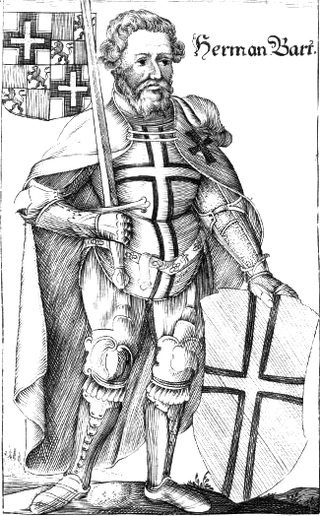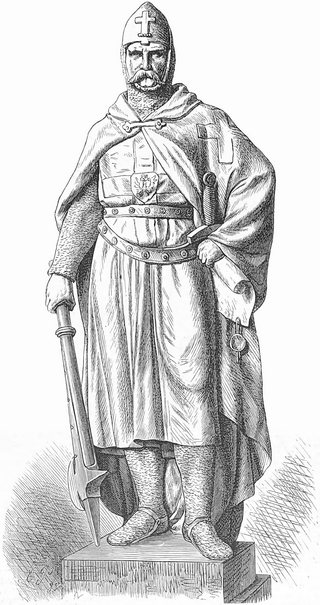
The Teutonic Order is a Catholic religious institution founded as a military society c. 1190 in Acre, Kingdom of Jerusalem. The Order of Brothers of the German House of Saint Mary in Jerusalem was formed to aid Christians on their pilgrimages to the Holy Land and to establish hospitals. Its members have commonly been known as the Teutonic Knights, having historically served as a crusading military order for supporting Catholic rule in the Holy Land and the Northern Crusades during the Middle Ages, as well as supplying military protection for Catholics in Eastern Europe.

The Livonian Order was an autonomous branch of the Teutonic Order, formed in 1237. From 1435 to 1561 it was a member of the Livonian Confederation.

Hermann von Salza was the fourth Grand Master of the Teutonic Knights, serving from 1210 to 1239. A skilled diplomat with ties to the Frederick II and the Pope, Hermann oversaw the expansion of the military order into Prussia.

The State of the Teutonic Order was a theocratic state located along the southeastern shore of the Baltic Sea in northern Europe. It was formed by the knights of the Teutonic Order during the early 13th century Northern Crusades in the region of Prussia. In 1237, the Livonian Brothers of the Sword merged with the Teutonic Order of Prussia and became known as its branch — the Livonian Order. At its greatest territorial extent during the early 15th century, the State encompassed Chełmno Land, Courland, Gotland, Livonia, Estonia, Neumark, Pomerelia, Prussia and Samogitia.

Heinrich Walpot von Bassenheim, also known as Henry Walpot, was the first Grand Master of the Teutonic Knights serving from 1198 to sometime before 1208.

Heinrich von Tunna, also Heinrich Bart and sometimes inaccurately referred to as Herman Bart was the third Grandmaster of the Teutonic Order, heading the order from 1208 to his death in 1209.
Gerhard von Malberg was the sixth Grand Master of the Teutonic Order, serving from c. 1241 to 1244. He was forced to resign from the office, and he does not appear in lists of the order's Grand Masters compiled in the 15th and 16th centuries.

Balga was a medieval castle of the Teutonic Knights in Kaliningrad Oblast, Russia. The castle ruins are located on the shore of the Vistula Lagoon, north of Mamonovo in the Pogranichny municipality of Bagrationovsky District, about 30 km (19 mi) southwest of Kaliningrad.

The grand master of the Teutonic Order is the supreme head of the Teutonic Order. It is equivalent to the grand master of other military orders and the superior general in non-military Roman Catholic religious orders. Hochmeister, literally "high master", is only used in reference to the Teutonic Order, as Großmeister is used in German to refer to the leaders of other orders of knighthood.

Anno von Sangerhausen was a German nobleman who served as the tenth Grand Master of the Teutonic Order from 1256 to 1273.

Heinrich von Hohenlohe was a German nobleman who served as the seventh Grand Master of the Teutonic Order from 1244 to 1249. He was the son of one of the richest and most powerful feudal lords in Württemberg and had four brothers and one sister.

Hans von Baysen or Jan Bażyński was a Prussian knight and statesman, leader of the Prussian Confederation and the first Polish governor of Royal Prussia.

Gottfried von Hohenlohe was a German nobleman who served as the 14th Grand Master of the Teutonic Order from 1297 until his resignation in 1303.
Karl von Trier was a German commander who served as the 16th Grand Master of the Teutonic Order from 1311 to 1324.

Martin Truchseß von Wetzhausen zu Dachsbach was the 34th Grand Master of the Teutonic Knights, serving from 1477 to 1489.

Kerpen (Eifel) is an Ortsgemeinde – a municipality belonging to a Verbandsgemeinde, a kind of collective municipality – in the Vulkaneifel district in Rhineland-Palatinate, Germany. It belongs to the Verbandsgemeinde of Gerolstein, whose seat is in the like-named town.

Hermann Balk, also known as Hermann von Balk or Hermann Balke, was a Knight-Brother of the Teutonic Order and its first Landmeister, or Provincial Master, in both Prussia and Livonia. From 1219 to 1227, he served as the Deutschmeister in the Order's Province of Alemannia. Balk led the crusaders during the Prussian Crusade and became Master of Prussia in 1230. From 1237 to 1238, he also served in the additional role as Master of Livonia.
The Treaties of Cölln and Mewe, concluded in 1454 and 1455, transferred the Neumark from the State of the Teutonic Order to the Electorate of Brandenburg. The Teutonic Knights had received the area as a pawn from Brandenburg in 1402, and as a possession in 1429. Financial shortages due to the onset of the Thirteen Years' War (1454–1466) forced Ludwig von Erlichshausen, Grand Master of the Teutonic Order, to pawn the Neumark to Frederick II, Elector of Brandenburg, by the Treaty of Cölln on 22 February 1454, and to subsequently sell it by the Treaty of Mewe on 16 September 1455.
Dietrich von Grüningen was a Knights Templar, Landmeister in Livonia and Landmeister of Prussia and Deutschmeister of the Teutonic Order. One of the most outstanding figures of the Teutonic Order in the 13th century.

Mergentheim Palace is a historic building located in Bad Mergentheim, Germany. The palace was first a castle, built in the early Middle Ages as the seat of the Taubergau, but then became a Teutonic possession in 1219, and then seat of the Mergentheim Commandery. The castle became the residence of the Grand Master of the Teutonic Order in 1527 and remained the headquarters of the Order until 1809.
















